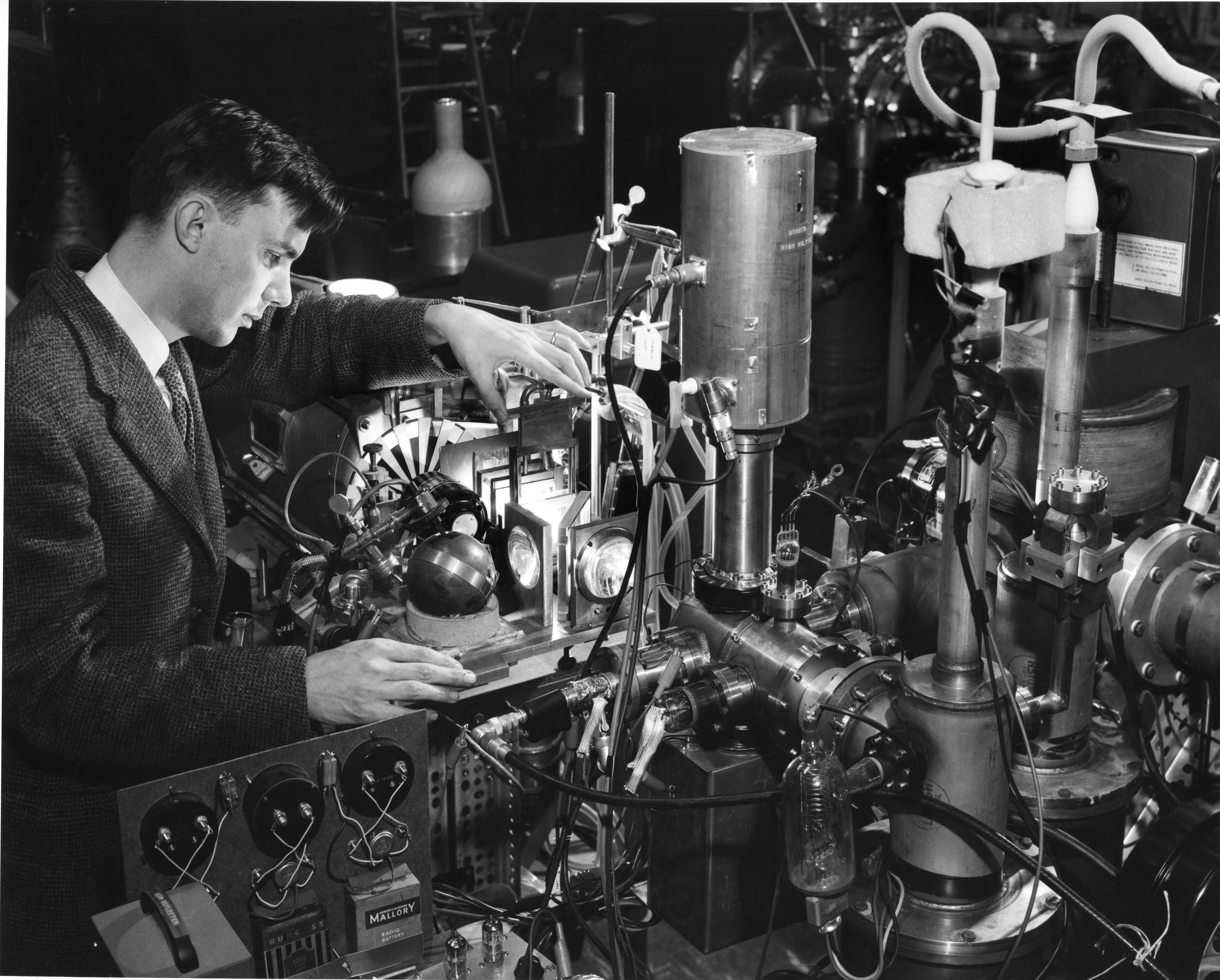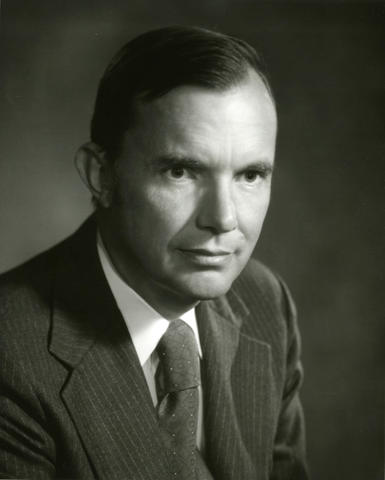Former NIST Director Lewis Branscomb Connected the Curiosity of Scientists With the Needs of the Nation

Lewis Branscomb, the director of the National Bureau of Standards (NBS) from 1969 to 1972, died in May at 96 years old. He led teams of scientists to pioneering discoveries, and when he left the agency, now known as National Institute of Standards and Technology (NIST), he was only 45, yet he had already clocked more professional achievements than most experience in a lifetime.
To go far it helps to start early, and Branscomb did that. He graduated from Duke University with a physics degree in 1945, when he was 19 years old, and earned his Ph.D. in mathematical physics from Harvard University four years later. He joined NBS in 1951 and immediately set out to prove a theory about the Sun.
That theory had been derived from mathematical and physical principles, but no one had yet succeeded in making the difficult measurements needed to prove it. In the roiling atmosphere of the Sun, the theory held, charged atoms, or ions, of hydrogen absorbed some of the Sun’s radiation, changing the wavelengths of light that reach us here on Earth. To prove the theory, Branscomb would have to measure the absorption of light by hydrogen ions in the lab.
This would have been relatively easy a decade later, when he could have used a laser as a light source. But lasers hadn’t been invented yet, so Branscomb built a complex measurement apparatus that at one point combined the arc lamp of a cinema projector with the red and green lenses of a traffic light.
It took Branscomb three years to make the measurement, and he did confirm the theory about the Sun. More importantly, he developed new ways to measure the fundamental properties of ions and how they behave in atmospheric gases. This allowed scientists to figure out what kinds of atoms were in the atmospheres of distant stars based on the wavelengths of light they emitted. It also applied to phenomena here on Earth, where ions interact to form pollutants in the atmosphere and, in the ozone layer, protect us from ultraviolet radiation.

Branscomb made his reputation in experimental physics by pulling off challenging laboratory measurements like that one. But he was also quickly recognized for his ability to attract funding to large research projects and make them successful. An official NIST history said that “these qualities were combined in his nature with a very persuasive personality to make him the center of a whirlwind of activity.”
“He could talk,” said Wolfgang Wiese in a phone interview. Wiese, a physicist Branscomb recruited to NBS in 1960, added, “He could convince people. When he got convinced of something, he was very powerful in getting people enthusiastic about it.”
Branscomb also had a knack for hiring the right people and encouraging their curiosity. Jan Hall, who came to NBS in 1961 as a postdoc in Branscomb’s division and went on to win the Nobel Prize in Physics, said he and his colleagues did not always know what the practical applications of their research would be, but they pursued their ideas out of pure curiosity.
“Branscomb didn’t see that as a waste of time, but as exactly the thing we were supposed to be doing,” Hall said in a phone interview. “We were like kids having an adventure. A lot of things came out of that community.”
At the same time, Branscomb served on many government committees, including President Lyndon B. Johnson’s Science Advisory Committee during the early years of the Apollo project. This gave him insights into the technological priorities of government and industry and allowed him to channel the creativity of NBS researchers toward the needs of the nation.
“The thing that Branscomb was most important for is the idea that it is reasonable to use public funds for something that we can’t explain exactly why it will be important,” said Hall, whose Nobel-winning breakthroughs with lasers and the optical frequency comb, a technique for precisely measuring light frequencies, ended up having enormous practical applications across the industrial economy. “He was one of the fathers of publicly funded research in the U.S.”
In 1962, Branscomb co-founded the Joint Institute for Laboratory Astrophysics, a collaboration between NBS and the University of Colorado Boulder. In this, he was driven by an idea that was still relatively new at the time — that laboratory measurements made here on Earth could be used to understand phenomena in distant stars and galaxies. Experimental physicists including Jan Hall worked alongside astrophysicists at the institute on their common research interests.
Those interests evolved and expanded so much that the institute eventually dropped the word “astrophysics” from its name. Today it is known simply as “JILA,” and is a premier center of research and teaching focused on atomic and molecular physics, quantum information science, nanoscience and other critical technologies. In an unpublished 2012 interview in which he looked back on his long career, Branscomb described JILA as his “greatest institutional achievement.”
Branscomb became the sixth director of NBS following his nomination by President Richard Nixon in 1969. With his growing reputation and talent for persuasive communication, he quickly raised the agency’s stature. An article in Science Magazine described Branscomb as “the man who aroused the low-profile and somewhat sleepy agency to such prominence in recent years.” But his directorship did not last long. Branscomb left NBS in 1972, after two and a half years in the director’s office.
The second half of Branscomb’s life was as productive as the first. He spent the next decade and a half as chief scientist at IBM, at a time when the company was developing new semiconductor and networking technologies and designing its first personal computers. He then went on to become director of the Science, Technology and Public Policy Program at the John F. Kennedy School of Government at Harvard University. In his speaking and writing he continued to advocate for public investment in scientific research and argued that science education and scientific literacy are critical to the health of democratic societies. In recognition of his support of ecological research and protection, a glacier in Antarctica is named after him.
In his book Confessions of a Technophile, published in 1995, Branscomb described what it was like to be a research physicist in the late 1940s. “At every hand there were wonderful opportunities for discovery,” he wrote. “There was more exciting physics than anyone could hope to do in a lifetime.”
It is amazing how much progress was made in just one lifetime. Where Branscomb made measurements using the light from a cinema projector lamp and traffic light lenses, today scientists use extreme ultraviolet light to etch billions of precisely formed transistors onto a single computer chip. A good deal of that progress was made by the many scientists Branscomb led and inspired. He enlarged the space for scientists to do fundamental research with no obvious near-term payoff. In the end, the payoff for science and the nation was immense.
Lewis Branscomb in ‘The Romance of Precision Measurement’
In 1953, then-NBS director Allen V. Astin spoke before the American Physical Society about the institute’s values and the critical role scientific advances played in supporting U.S. industry. It’s a message that has resonated with NIST directors ever since, including Lewis Branscomb. (Branscomb clip at 2:58.)

